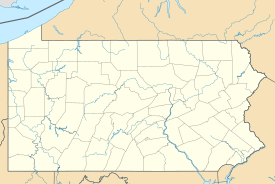Carrie Furnaces
| Carrie Furnaces 6 & 7 | ||
|---|---|---|
| National Register of Historic Places | ||
|
2007 view |
||
|
|
||
| location | Allegheny County , Pennsylvania , United States | |
| Coordinates | 40 ° 24 '47.1 " N , 79 ° 53' 24.3" W | |
| surface | 5 hectares | |
| Built | 1907 | |
| NRHP number | 06001070 | |
| The NRHP added | September 20, 2006 | |
The Carrie Furnaces are two disused, 28 meter high blast furnaces on the Monongahela River in Swissvale near Pittsburgh , Pennsylvania. The complex was one of the former steelworks Homestead Steel Works .
description
The plant includes two identical blast furnaces with inclined elevators for loading. There is a chimney, six heaters and furnace gas pipes. A 15-ton gantry crane runs over the bunkers for iron ore , coke and aggregates . There is also a casting hall next to the 67 meter long blower hall. The area of the historical complex is around five hectares .
The total area of the Carrie Furnaces was 68 hectares (168 acres ). Of this, 8.5 hectares are located south of the river, and 15 hectares on the north bank are designated as green zones. Of the remaining 44 hectares, Allegheny County Economic Development can sell about 30 to investors.
history

The two preserved blast furnaces "6" and "7" were in operation between 1907 and 1972 and were last modernized in 1936. The facility is one of the few of its kind that was built before the Second World War . The five older Carrie Furnaces 1-5 were removed after the plant was closed. The first blast furnaces went into operation in 1884 and, like neighboring plants, were named after a female family member of the owner. So there were also “Dorothys” and “Lucys” in the region with 75 blast furnaces. A nine-kilometer-long Eliza Furnace Trail is marked out close to the city center.
After initially selling pig iron as an independent trader, the plant was acquired by Andrew Carnegie in 1898 . They came to US Steel from the Carnegie Steel Company in 1901 . At the zenith of their production, 1000 to 1250 tons of pig iron were produced in each of the two blast furnaces per day. That required four times the amount of raw materials and five million gallons of water for cooling. 3,000 workers were employed at the plant, while up to 15,000 steelworkers worked across the river. With the Carrie Furnace Hot Metal Bridge (not to be confused with the downstream Hot Metal Bridge at the J&L Steel plant ) they were connected to the steelworks. Ladle wagons each carried 35 tons of molten iron to Homestead on the south side of the river. Since their shutdown, the factory facilities have been a popular lost place and a well-known photo opportunity for industrial architecture. In the 1990s it was controversial whether the complex should be preserved as an industrial monument.
The blast furnaces have been a listed building since 1989 and have been part of the Rivers of Steel National Heritage Area since 1997 . Its properties are spread over eight counties . It belongs to 12 State Heritage Areas in Pennsylvania and is one of 49 National Heritage Areas in the USA.
Rivers of Steel is currently offering tours and courses. The area is also used for art exhibitions and creative activities. Events such as weddings can be held on the premises. The Pittsburgh Garden Trail offers a monthly guided tour of the green areas and brownfield sites.
The area, which in 2013 was still poorly accessible between railway systems, has now been connected to road traffic via Carrie Furnace Boulevard . On the north bank of the river, investors have an area of around 30 hectares east and west of the blast furnaces. Another road connection and the connection to the Great Allegheny Passage trail and the Eliza Furnace Trail could be realized via the Hot Metal Bridge.
The cost of converting the facility into a museum is estimated at $ 70 million to $ 100 million. In 2008, a park-and-ride car park with a tram connection for commuters was proposed.
Web links
- Official website: Name: Carrie Blast Furnaces National Historic Landmark - Rivers of Steel. In: riversofsteel.com. June 20, 2017, accessed June 14, 2020 .
- Jim Cheney: Touring the Once-Abandoned Carrie Furnace in Pittsburgh - Uncovering PA. In: uncoveringpa.com. April 1, 2020, accessed on June 14, 2020 .
- MJ Slaby: Pittsburgh's iconic blast furnaces were named after local women. In: The Incline. September 25, 2018, accessed June 26, 2020 . (With a photo of the entire facility in 1936)
Individual evidence
- ↑ a b Name: Carrie Blast Furnaces National Historic Landmark - Rivers of Steel. In: riversofsteel.com. June 20, 2017, accessed June 14, 2020 .
- ↑ a b Carrie Furnace - Data. Retrieved June 14, 2020 .
- ↑ a b c d Bob Downing: Rust, grit mark Pittsburgh's historic and colorful Carrie Furnaces that produced iron for steel making. In: beaconjournal.com. May 25, 2013, accessed July 2, 2020 .
- ↑ a b Name: Carrie Furnace Redevelopment. In: carriefurnacesite.com. Retrieved July 2, 2020 .
- ^ MJ Slaby: Pittsburgh's iconic blast furnaces were named after local women. Here's why. Edith, Isabella, Lucy, Ann, Carrie, Eliza, and Dorothy. In: The Incline. September 25, 2018, accessed June 26, 2020 .
- ^ Beyond Rust. University of Pennsylvania Press, 2016, ISBN 0812247671 p. 280 ( limited preview in Google Book Search).
- ↑ PITTSBURGH HISTORY & LANDMARKS FOUNDATION: Historic Landmark Plaques 1968–2009. Retrieved June 14, 2020 . (PDF file)
- ↑ CARRIE FURNACES, A RIVERS OF STEEL SITE - Pittsburgh Garden Trail. In: pittsburghgardentrail.com. Retrieved June 15, 2020 .


